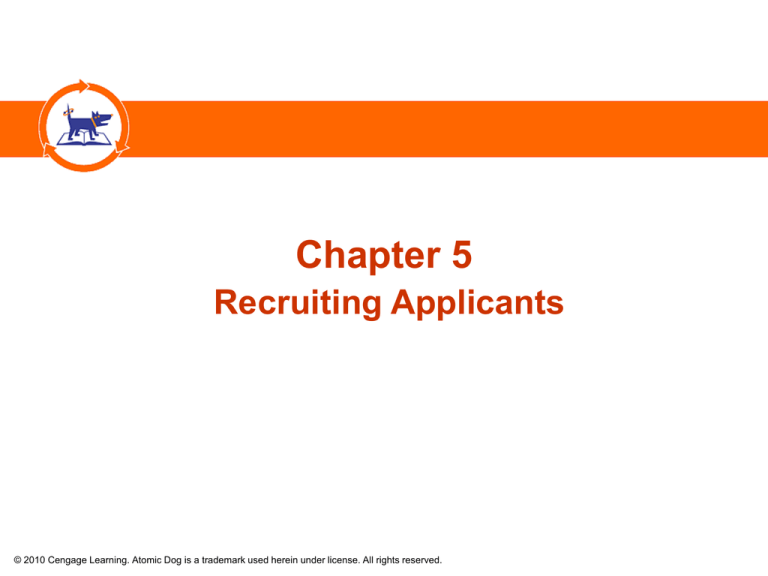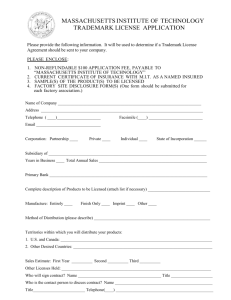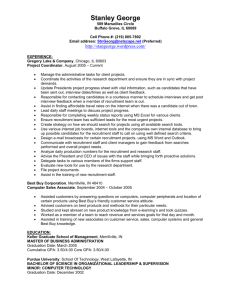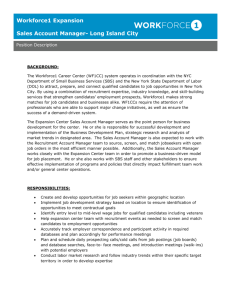
Chapter 5
Recruiting Applicants
© 2010 Cengage Learning. Atomic Dog is a trademark used herein under license. All rights reserved.
Chapter Outline
•
5-1 Gaining Competitive Advantage
•
5-2 HRM Issues and Practices
•
5-3 The Manager’s Guide
© 2010 Cengage Learning. Atomic Dog is a trademark used herein under license. All rights reserved.
5-1a Opening Case: Gaining Competitive
Advantage at the Los Angeles United
School District
•
Problem: A poor recruiting system resulting in lowquality hires.
•
Solution: Using an online system and rolling out the
red carpet.
•
How the new recruitment process enhanced
competitive advantage
District attracts top candidates, with 95 percent of new
hires in the past year being highly qualified.
Through use of automated services, the district saves
about $10 million per year.
© 2010 Cengage Learning. Atomic Dog is a trademark used herein under license. All rights reserved.
5-1b Linking Recruitment to Competitive
Advantage
•
A recruiting program has five goals:
1.
2.
3.
4.
5.
Achieve cost efficiency.
Attract highly qualified candidates.
Help ensure that individuals who are hired will stay
with the company.
Assist a company’s efforts to comply with
nondiscrimination laws.
Help a company create a more culturally diverse
workforce.
© 2010 Cengage Learning. Atomic Dog is a trademark used herein under license. All rights reserved.
5-1b Linking Recruitment to Competitive
Advantage (cont.)
•
Achieving cost efficiency: Reducing recruitment costs
without lowering productivity can help enhance
competitive advantage.
•
Attracting highly qualified candidates
Sufficient number of qualified candidates must be
notified of available opportunities.
Actions must be taken to enhance the likelihood that
the best applicants will accept their job offers.
© 2010 Cengage Learning. Atomic Dog is a trademark used herein under license. All rights reserved.
© 2010 Cengage Learning. Atomic Dog is a trademark used herein under license. All rights reserved.
5-1b Linking Recruitment to Competitive
Advantage (cont.)
•
Improving job retention rates through the use of
realistic job previews (RJPs)
RJPs can reduce turnover by giving applicants more
realistic information about the job and the
organization.
Applicants can make a more informed choice about
whether or not to accept the job offer.
Reducing turnover rates can result in substantial
savings.
© 2010 Cengage Learning. Atomic Dog is a trademark used herein under license. All rights reserved.
5-1b Linking Recruitment to Competitive
Advantage (cont.)
•
Achieving legal compliance: Organizations can help
prevent discrimination charges by targeting
recruitment efforts toward underutilized groups.
•
Extending recruitment practices to disadvantaged
groups can create a more culturally diverse
workforce.
•
Many companies have begun reaching out to
seniors, minorities, welfare-to-work candidates, and
people leaving the armed forces.
•
The manner in which a company treats these
candidates during the recruitment process is vital.
© 2010 Cengage Learning. Atomic Dog is a trademark used herein under license. All rights reserved.
© 2010 Cengage Learning. Atomic Dog is a trademark used herein under license. All rights reserved.
5-2a Recruitment Planning
•
Step 1: Identify the job opening
•
Organizations should attempt to identify job openings
well in advance of an announced resignation.
The HRM department should plan for future openings,
thus providing organizations with the time needed to
plan and implement recruitment strategies.
Step 2: Decide how to fill the job opening
Whether to use core or contingency personnel.
If core personnel are to be used, should the firm
recruit them internally or externally.
© 2010 Cengage Learning. Atomic Dog is a trademark used herein under license. All rights reserved.
5-2a Recruitment Planning (cont.)
•
Core personnel
•
Hired in the “traditional” manner.
Considered permanent employees.
Included in the organization’s payroll.
Contingency personnel
Employed by a supplier agency, and “loaned” to the
organization.
Not included in the organization’s payroll.
Supplier pays the workers’ salaries and benefits.
Fall into three major categories: temps, outsourcing,
and independent contractors.
© 2010 Cengage Learning. Atomic Dog is a trademark used herein under license. All rights reserved.
5-2a Recruitment Planning (cont.)
•
Advantages of using contingency personnel:
Flexibility to control fixed employee costs.
Relieves a company of many of its HRM burdens.
Cost savings.
Contingency workers who excel at their jobs can be
offered core positions.
© 2010 Cengage Learning. Atomic Dog is a trademark used herein under license. All rights reserved.
5-2a Recruitment Planning (cont.)
•
Disadvantages of contingency personnel:
May need a considerable amount of orientation and
training regarding company procedures and policies.
Might be less loyal or committed to the “host
organization.”
May receive better wages than core workers, leading
to resentment among core employees.
© 2010 Cengage Learning. Atomic Dog is a trademark used herein under license. All rights reserved.
5-2a Recruitment Planning (cont.)
•
Use contingency workers in situations when:
Certain types of hard-to-find expertise are required.
Companies are trying to staff new offices in
geographic areas far from main headquarters.
Companies are trying to staff positions to work on
projects in which unusually high risk factors may
jeopardize a company’s existing workers’
compensation rates.
© 2010 Cengage Learning. Atomic Dog is a trademark used herein under license. All rights reserved.
5-2a Recruitment Planning (cont.)
•
Advantages of internal recruitment:
•
Enhance morale and motivation.
Qualifications of internal candidates are well known;
openings can be filled more quickly.
Less expensive.
Internal candidates are more familiar with
organizational policies and practices, requiring less
orientation and training.
Disadvantages of internal recruitment:
Rejected candidates may become resentful.
Workers promoted into supervisory positions may find
it difficult managing former coworkers.
© 2010 Cengage Learning. Atomic Dog is a trademark used herein under license. All rights reserved.
5-2a Recruitment Planning (cont.)
•
External recruitment is limited primarily to entry-level
jobs.
•
External recruitment for jobs above the entry level is
usually restricted to the following situations:
An outsider is needed to expose the organization to
new ideas and innovations.
No qualified internal candidates apply.
The organization needs to increase its percentage of
employees within a particular underutilized group.
© 2010 Cengage Learning. Atomic Dog is a trademark used herein under license. All rights reserved.
5-2a Recruitment Planning (cont.)
•
Step 3: Identify the target population
•
Specify worker requirements.
Decide whether to target certain segments of the
applicant population.
Step 4: Notify the target population
Limit the size of the applicant pool by attracting only
the most qualified applicants.
-
A good way to do this is to clearly state the job
qualifications in the vacancy notification.
© 2010 Cengage Learning. Atomic Dog is a trademark used herein under license. All rights reserved.
5-2a Recruitment Planning (cont.)
•
Step 5: Meet with the candidates
Gives the firm a chance to further assess the
candidates’ qualifications.
Provides candidates an opportunity to learn more
about the company and the employment opportunity.
© 2010 Cengage Learning. Atomic Dog is a trademark used herein under license. All rights reserved.
5-2b Methods of Internal Recruitment
Recruitment
Method
Strengths
Weaknesses
Computerized
career
progression
systems
• Candidates can be
found quickly.
• Limited to only objective or
factual information.
• Helps identify a broad
spectrum of candidates.
• Information of a more
subjective nature is excluded.
Supervisor
selection
• Very popular with
supervisors.
• Usually very subjective.
• Supervisor is in a good
position to know the
capabilities of potential
candidates.
• Some qualified employees
may be overlooked.
• Susceptible to bias, leading
to possible discrimination.
© 2010 Cengage Learning. Atomic Dog is a trademark used herein under license. All rights reserved.
5-2b Methods of Internal Recruitment
(cont.)
•
Job posting
Strengths
- Enhances the probability that the firm’s most qualified
employees will be considered for the job.
- Gives employees an opportunity to become more
responsible for their career development.
- Enables employees to leave a “bad” work situation.
© 2010 Cengage Learning. Atomic Dog is a trademark used herein under license. All rights reserved.
5-2b Methods of Internal Recruitment
(cont.)
•
Job posting
Weaknesses
-
Position may remain open for an extended period.
The system may prevent supervisors from hiring
individuals of their choice.
Some employees may hop from job to job without any
clear direction.
Employees whose bids are rejected may become
alienated.
© 2010 Cengage Learning. Atomic Dog is a trademark used herein under license. All rights reserved.
5-2b Methods of Internal Recruitment
(cont.)
•
Career development systems
Strengths
-
The firm’s top performers are more likely to remain with
the organization.
Such systems ensure that someone is always ready to
fill a position when it becomes open.
Weaknesses
-
An employee not selected for grooming may become
disenchanted with the organization and leave.
Selected employees may become frustrated if the
expected promotion does not materialize because the
position never becomes vacant.
© 2010 Cengage Learning. Atomic Dog is a trademark used herein under license. All rights reserved.
5-2c Methods of External Recruitment
•
Employee referrals
Strengths
-
Is effective, quite popular, and cost efficient.
Employees accurately judge the ‘‘fit’’ between the job
being filled and the individual, and refer only the highest
quality applicants.
Applicants referred by employees tend to perform better
and stay longer.
Weaknesses
-
May serve as a barrier to equal employment opportunity.
© 2010 Cengage Learning. Atomic Dog is a trademark used herein under license. All rights reserved.
5-2c Methods of External Recruitment
(cont.)
Recruitment
Method
Strengths
Weaknesses
Applicantinitiated
recruitment
• Efficient and low cost.
• There may be no jobs
available when the
applications come in or by
the time a job becomes
vacant, many of these
individuals may have already
found other jobs.
•Candidates are likely to
be highly motivated.
Help-wanted
• Large audience can be
advertisements reached in a relatively
short period of time.
• Aids in ensuring equal
opportunity to apply for
job openings.
• Often ineffective.
• May attract too many
applicants, making the
screening process
cumbersome.
© 2010 Cengage Learning. Atomic Dog is a trademark used herein under license. All rights reserved.
5-2c Methods of External Recruitment
(cont.)
•
Employment agencies – public
Most frequently provide personnel for clerical and
blue-collar jobs.
Cost is low as the agency does not charge employers
a fee.
The method is efficient as jobs can be filled fairly
quickly.
Applicants may lack motivation.
© 2010 Cengage Learning. Atomic Dog is a trademark used herein under license. All rights reserved.
5-2c Methods of External Recruitment
(cont.)
•
Employment agencies – private
Have the resources to fill a wide variety of jobs.
Candidates register with the agency voluntarily – thus
they may be more committed.
Agency charges a fee for its service.
They are especially useful when many individuals are
expected to apply for a job or when qualified
candidates are hard to find.
© 2010 Cengage Learning. Atomic Dog is a trademark used herein under license. All rights reserved.
5-2c Methods of External Recruitment
(cont.)
•
Executive search firms
Specialize in the recruitment of mid- and senior-level
managers.
Charge the employer a large fee for their services.
Can be unsuccessful – only 50 to 60 percent of all
executive searches result in the selection of the type
of individual initially specified.
© 2010 Cengage Learning. Atomic Dog is a trademark used herein under license. All rights reserved.
5-2c Methods of External Recruitment
(cont.)
•
Campus recruiting
•
Used to fill specialized entry-level jobs.
Is costly and time consuming.
Recruitment process can be rather slow.
Online recruiting
Is becoming quite popular.
Is much faster and reaches a much larger audience
compared to newspaper advertising.
Can be quite expensive.
Not the best approach for reaching external
candidates.
© 2010 Cengage Learning. Atomic Dog is a trademark used herein under license. All rights reserved.
© 2010 Cengage Learning. Atomic Dog is a trademark used herein under license. All rights reserved.
5-2c Methods of External Recruitment
(cont.)
•
Choosing the right method: The following factors are
the most relevant:
The type of job being filled.
How quickly the job needs to be filled.
The geographic region of recruitment.
The cost of implementing the recruitment method.
Whether the method will attract the right mix of
candidates from an EEO perspective.
© 2010 Cengage Learning. Atomic Dog is a trademark used herein under license. All rights reserved.
5-3a HR Recruitment and the Manager’s
Job
•
The line manager plays three key roles in the
recruitment process.
Identifying recruitment needs triggered by
replacement, additional positions being added, and a
newly created job being established.
Communicating recruitment needs to the HRM
department including needed skills/qualifications for
the job and attractive and unattractive features of the
job.
Interacting with applicants to keep them informed of
the status, schedule interviews at their convenience,
and allow them to speak to their future coworkers.
© 2010 Cengage Learning. Atomic Dog is a trademark used herein under license. All rights reserved.
5-3b How the HR Department Can Help
•
Planning the recruitment process: Determine where
to find the applicants and how to attract them.
•
Implementing the recruitment process: Includes
writing an ad, choosing the employment agency,
conducting campus interviews, and coordinating
candidates on-site visits.
© 2010 Cengage Learning. Atomic Dog is a trademark used herein under license. All rights reserved.
5-3b How the HR Department Can Help
(cont.)
•
Evaluating the recruitment process involves:
Calculating the number of applicants generated from
each recruitment method, the number hired, and the
job success of each hire.
Determining the cost-effectiveness of each recruitment
method.
Monitoring EEO statistics to ensure compliance.
© 2010 Cengage Learning. Atomic Dog is a trademark used herein under license. All rights reserved.
5-3c HRM Skill-Building for Managers
•
What Information to give candidates:
•
Describe what the
company does.
•
Describe the work setting.
•
Discuss salary.
•
Present relevant facts and
figures.
•
Describe the workweek
and the payroll period.
•
Describe the company’s
history.
•
Describe career
opportunities.
•
Describe the department.
•
•
Describe the job itself.
•
Describe yourself as a
manager.
Describe what employees
like best about the
company.
•
Encourage the applicant
to ask questions.
© 2010 Cengage Learning. Atomic Dog is a trademark used herein under license. All rights reserved.
5-3c HRM Skill-Building for Managers
(cont.)
•
How to provide the information
Make a favorable impression on the candidate.
Avoid acting defensively and being self-conscious.
Be easy to get along with and avoid discussing
irrelevant topics.
Answer the candidate’s questions satisfactorily.
To be viewed as personable, one should:
Display warmth and be enthusiastic about the
organization.
Show an interest in the applicant’s outside activities.
© 2010 Cengage Learning. Atomic Dog is a trademark used herein under license. All rights reserved.
5-3c HRM Skill-Building for Managers
(cont.)
•
Providing realistic job previews: Would appear to be
most suitable when the following conditions exist:
Turnover and associated separation costs are high.
There are negative facets of the job that applicants do
not know about, and these facets may strongly
influence their subsequent intentions to quit.
Qualified applicants are plentiful.
© 2010 Cengage Learning. Atomic Dog is a trademark used herein under license. All rights reserved.
5-3c HRM Skill-Building for Managers
(cont.)
•
When providing an RJP:
Include descriptive information.
Avoid giving candidates all possible information.
The relative emphasis given to positive and negative
information should reflect the actual balance of
positive–negative factors found in the environment.
© 2010 Cengage Learning. Atomic Dog is a trademark used herein under license. All rights reserved.








